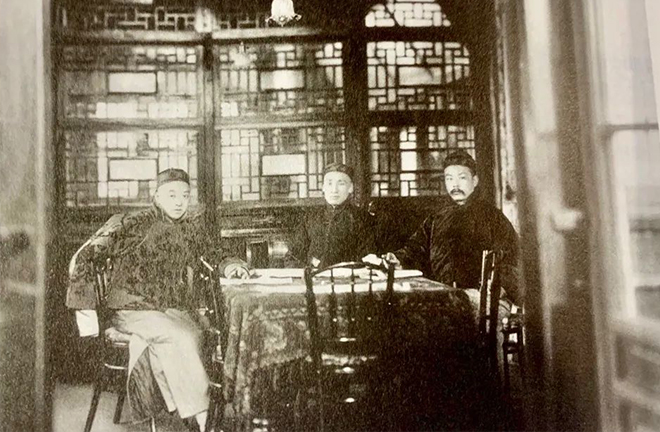Translation bridges the divide between cultures

The Translation House of Jiangnan Manufacturing Bureau established in 1868 by the Qing government. Photo: FILE
Translation plays an important role in the inheritance and development of culture. Cultural communication between the Chinese culture and cultures of other countries is carried out through translation activities, which draws the world closer and builds a bridge for cultural exchange and integration. Through long stretches of history, the translation of Buddhist scriptures, science and technology, philosophy, social sciences and literary works have fostered exchange and mutual learning between Chinese and foreign cultures.
Only by exchanging and learning from each other can civilization be full of vitality. An important reason why China has five thousand years of splendid culture is that it was able to integrate with a variety of foreign cultures. The communication between Chinese cultures and foreign cultures began with the translation of Buddhist scriptures. Translators such as the Indian Buddhist monk Kumārajīva, and Monk Xuanzang of the Tang Dynasty (618-907), brought Buddhist culture into traditional China. Kumārajīva initiated the blending of Chinese civilization and ancient Indian cultures through the practice of translation, and was considered a missionary who pioneered the exchange of civilization along the Silk Road. More than two hundred years later, master Xuanzang spent 17 years traveling Westward to Tianzhu (Sindhu, one of China's names for ancient India). He conquered the Silk Road with firm will, and collected plenty of Buddhist classics along the way. After returning to the Tang Dynasty, he spent 19 years translating Buddhist scriptures. He was a successful messenger who promoted exchange between two of the world’s most ancient civilizations.
Translation played a crucial role in the overseas dissemination of ancient Chinese technological inventions. Gunpowder is a prime example of this type of exchange. After the Battle of Talas (also known as the Battle of Artlakh, a conflict between the Arab Abbasid Caliphate and the Chinese Tang Dynasty), Chinese craftsmen spread many of the country’s technologies to the ancient Arab. By translating books from Arab, the Europeans came to know the existence of gunpowder.
Translation of Western books about science and technology reached a peak in the Ming and Qing dynasties. During the period, Chinese translation of Western scientific works was mostly done in cooperation with missionaries such as Matteo Ricci and Johann Adam Schall von Bell. While introducing China to new science and technologies, the missionaries also introduced the translated Chinese Confucian classics to Europe. After the Opium War in 1840, Lin Zexu and Wei Yuan organized the translation of a variety of Western books. The Translation House of Jiangnan Manufacturing Bureau was also founded in 1868. Since then, the translation of Western books and Western learning boomed, becoming an important way to bring Western modern science and technology to the late Qing Dynasty (1636-1911).
As for the translation of philosophy, social sciences and literary works, cultural exchanges between China and foreign countries were frequent. the Analects of Confucius was introduced to Japan as early as the third century AD. I Ching spread Westward into Europe in the early 17th century, and had a profound influence on European philosophy.
In the 1930s when cultural exchange was generally dominated by the "Eastward spread of Western culture" and when the West could hardly hear voices from China, Pearl Buck, an American female writer, translated the Water Margin, one of the Four Great Classical Novels of China, into English, which helped the then vulnerable Chinese culture amplify its voice in the West.
History has proved that cultural translation plays a big role in cultural exchange and mutual learning between China and foreign countries. At a time when national power was weak, China tried to find a way out by introducing Western science, technology and ideas. Nowadays, China is more involved, interacting in world politics, economies, and cultures. However, the cultural exchange between China and other countries is still unequal in some sense, and the understanding of Chinese culture by other countries is not yet deep enough. As China enhances its comprehensive national strength, and new ideas and theories keep emerging, China presents itself to the international community in a multifaceted way and the role of translation becomes increasingly important.
China must increase cooperation in translation and publication. These fields provide a great impetus for Chinese culture to "go global." Translating and publishing each other's classical works, with the help of mainstream media or publishing agencies, can achieve equal cultural communication and better recount Chinese stories.
China should also strengthen the cultivation of talent, which is a long-term and systematic process. Senior translators should not only study the cultures and customs of different countries, but also have a good mastery of classical Chinese culture. While training qualified native translators, the role of foreign translators should not be overlooked, and translators with dual cultural backgrounds also play an important role.
It is also important to adopt methods which combine domesticating translation and foreignizing translation. The former denotes the translation skill which changes the source language’s value and culture so as to make a piece readable for the target language readers, while the latter denotes the skill that keeps the values of the source language and culture. The two skills can be combined to seek common ground while preserving differences in culture exchange.
Cao Hongxia is from the School of Foreign Languages and Cultures at Nanjing Normal University.
Edited by BAI LE
